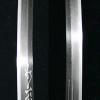Attribution
Workmanship and styleShape and constructionMade in torii-zori. HorimonoOmote: So no kurikara made shallow in the style of Hizen Munenaga HamonTogari-gunome made of ko-nie in nioi with lots of activity. Numerous kakikake mixed with sunagashi, kinsuji are seen. BoshiKo-maru with hakikake. Jitetsu and hadaO-mokume with running masame tendency in the ha. Some ayasugi is visible. NakagoLength: 13.9 cm. Nakago has 3 mekugi-ana, the one in the middle being larger than the others. NotesShinto wakizashi in good polish. Blade is kept in old shirasaya of high quality. Mekugi is made of deep horn, mekugi-ana - ivory. Signature can be translated as: Made in 1624 (first year on Kanei era) by Sadatoshi, lay priest of Gyōen, resident of Chikugo province. Owned by 'Odoribu' Asahina Genzaemon. SadatoshiAccording to Meikan (thanks to Harry Watson for providing this information), there is a Sadatoshi with a Gō of GYŌEN NYŪDŌ. That means that his name as a lay priest is Gyōen. However, it says that both the time he worked and where he lived is unknown, but he is placed in the Shintō period. If the mei is original, it tells exactly when and where Sadatoshi lived and worked: 1624, Chikugo province. 'Dancing Buddha'The word written above the owner's name is 踊佛 - odoribu, or odoribotoke, which can be translated as 'dancing Buddha'. There could be few versions what that word means:
I'm leaving it to the reader to decide which version sounds more plausible. Special thanks to Kimiyo Kuroya and Harry Watson for all their great help with reading the mei. Gyouen nyudo (priest of Gyouen). Era and province is unknown. (References: Soran) |
|||||||||||||||||||||||||||||||||||||||||||||||||||||||||||||||
 |
Nihonto ClubJapanese Sword Information Exchange |
User login |
|
|
Disclaimer: Nihontō Club owners and independent contributors will not be held responsible for any loss, damage or inconvenience caused as a result of any inaccuracy or error within this website. Except where otherwise noted, this page is licensed under a Creative Commons License.
|


Inscription
A general comment on this part:
踊佛朝比奈源左衛門所持
Would it be possible that it could state ownership?
"朝比奈源左衛門所持"
Genzaemon shoji - Genzaemon owner
Asahina - Asahina clan
Asahina Genzaemon owner
To further elaborate the first part "踊佛".
This was translated by Nobuo Nakahara (at the Amsterdam session 2019-10-12) as "Dancing Monk" or "The Dancing Monk".
踊佛 could mean "Monk Warrior".
Monk warriors did appear in the mid 1700th century. As the blade also has a date "Kanei gan"/ 1624 this is a possible solution.
Questions:
Was Genzamon a warrior monk of the Asahina clan?
Was the blade handed over to Genzaemon as a gift for his services for the Asahina clan and inscribed as such "所持"/Shoji/Owner?
/Martin Einarsson 2019-10-16
NIHONTO EUROPE
Horimono
I found almost identical horimono in Dai Token Ichi catalog for 2010, page 14 (katana by Yukihira).